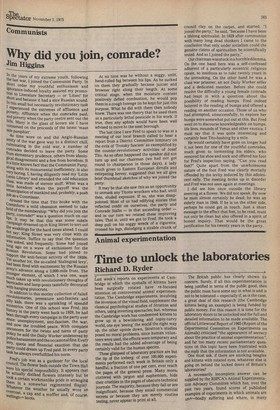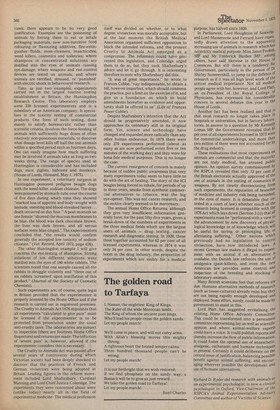Animal experimentation Time to unlock the laboratories Richard D. Ryder
Last week's reports on experiments at Cambridge in which the eyeballs of kittens have been surgically rotated have re-focused attention on controversial animal experimentation. The Cambridge experiments, involving the inversion of the visual field, supplement the classical psychological studies of Stratton and others, using inverting spectacles; but, whereas the Cambridge work has condemned kittens to grow up in a bewildering and topsy-turvy world, one eye 'seeing' the world the right way up, the other upside down, Stratton's studies posed no moral problems, since human volunteers were used, the effects were temporary and the results had the added advantage of being certainly valid for the human species.
These glimpsed of laboratory practice are but the tip of the iceberg: of over 100,000 experiments performed each week in Britain only a handful, a fraction of one per cent, ever reach the pages of the general press. Many more cluttered with jargon and euphemism, hide their cruelties in the pages of obscure technical journals. The majority, because they fail or are insignificant, because they entail commercial secrets or because they are merely routine testing, never appear in print at all.
The British public has clearly shown its concern. Surely, if all this experimentation is being justified in terms of the public good, then the public must have some say in what is and is not to be tolerated — expecially if, as is the case, a great deal of this research (the Cambridge kittens being an example) is being funded by public money. For this reason it is time for the laboratory doors to be unlocked and for full and detailed information to be made available. The official Littlewood Report of 1965 (Report of the Departmental Committee on Experiments on Animals) criticised "the appearance of secrecy about the practice of animal experimentation", and far too many recent parliamentary questions on this topic have been frustrated with the reply that the information is not available.
One must ask, if there are smoking beagles and kittens with rotated eyes, whatever else is going on behind the locked doors of Britain's laboratories?
A necessarily incomplete answer can be supplied by the RSPCA's Animal Experimentation Advisory Committee which has, over the past two years, found scores of published examples of experiments in which animals are unri"ibtedly suffering and where, in many cases, there appears to be no very good justification. Examples are the poisoning of. animals by forcing them to eat or inhale packaging materials, new non-nutritive food colouring or flavouring additives, fire-extinguisher fluids, oven-cleaners, insecticides, weed killers, cosmetics and toiletries; where shampoos in concentrated solutions are instilled into the eyes of animals causing eye-damage; where weapons and riot-control devices are tested on animals; and where animals are terrified, stressed, or 'punished' with electric shock in behavioural research. _
Take, as just two examples, experiments carried out in the largest routine -testing establishment in Britain, the Huntingdon Research Centre. This laboratory employs some 238 licensed experimenters and is a subsidiary of an American company. It specialises in the toxicity testing of commercial products. One form of such testing, done mainly to satisfy bureaucratic rather than scientific criteria, involves the force-feeding of animals with sufficiently huge doses of often relatively non-poisonous materials, to discover what dosage level kills off half the test animals within a specified period such as fourteen days. One can easily imagine how much suffering may be involved if animals take as long as two weeks dying. The range of species used at Huntingdon is considerable and has included dogs, mice, piglets, baboons and monkeys. (House of Lords, Hansard, May 1, 1975).
In one experiment, a veterinary surgeon at Huntingdon poisoned pedigree beagle dogs with the weed-killer, sodium chlorate. The dogs were poisoned by stomach-tube over the course of five days during which time they showed "marked loss of appetite and.body-weight with lasitude, vomiting and blood-streaked faeces ... death occurred on day four." A post-mortem on one female "showed the mucous membranes to be blue, the blood was dark chocolate brown, the liver was dark brown, and all serous surfaces were blue-tinged." The experimenters concluded that "the results would confirm generally the accepted low toxicity of sodium chlorate." (Vet. Record, April 1972, page 416).
The other Huntingdon example I will give concerns the eye-testing of shampoos. Strong solutions of ten different solutions were instilled into the eyes of 180 white rabbits. The scientists noted that one sample caused all the rabbits to struggle violently and "three out of six rabbits `screamed' upon instillation of this product." (Journal of the Society of Cosmetic Chemists).
Such experiments are, of course, ,quite legaL in Britain provided that the experimenter is properly licensed by the Home Office and if the research is carried out in registered premises. The Cruelty to Animals Act 1876 stipulates that all experiments "calculated to give pain" must be licensed if the experimenter is to be protected from prosecution under the usual anti-cruelty laws. The laboratories are subject to inspection (there are fourteen Home Office Inspectors) and returns are made. The infliction of `severe pain' is, however, allowed if the experimenter considers this is necessary.
The Cruelty to Animals Act was passed after several years of controversy during which Victorian society had been deeply shocked to discover that the practices of French and German vivisectors were being adopted in Britain. Leading figures in the reform movement included Lord Shaftesbury, Cardinal Manning and Lord Chief Justice Coleridge. The experiments they were concerned about were (unlike today) nearly all in the field of experimental medicine. The medical profession itself was divided on whether, or to what degree, vivisection was morally acceptable, but at the last moment the British Medical Association organised sufficient opposition to block the intended reforms, and the present Cruelty to Animals Act emerged as a compromise. The reformers could have prevented this legislation, and Coleridge urged them to do so, but they took Shaftesbury's advice and let it go through. It is interesting therefore to note why Shaftesbury did this: "It was of great importance," he wrote to Frances Cobbe, "nay indispensable, to obtain a bill, however imperfect, which should condemn the practice, put a limit on the exercise of it, and give us a foundation on which to build amendments hereafter as evidence and opportunity shall be offered to us" (Life of Frances Power Cobbe).
Despite Shaftesbury's intention that the Act should be progressively amended, it now approaches its centenary still in its original form. Yet, science and technology have changed and expanded more radically than any other human endeavour. In 1878 there were only 270 experiments performed (about as many as are now performed every five or ten minutes of the working day) and they were for bona fide medical purposes. This is no longer the case.
The current resurgence of concern is mainly because of sudden public awareness that very many experiments today seem to have little to
do with the art of healing. The story of the ICI beagles being forced to inhale, for periods of up
to three years, smoke from synthetic commercial alternatives to tobacco, was the big eye-opener. This was not cancer research, and the motive clearly seemed to be mercenary.
The annual Home Office Returns, although they give very insufficient information gen erally have, for the past fifty-five years, given a break-down of the numbers of experiments in the three medical fields which are the largest users of animals — drug testing, cancer research and diagnostic testing. In 1920, these three together accounted for 62 per cent of all licensed experiments, whereas in 1974 it was only 34 per cent. In other words, despite the boom in the drug industry, the proportion of experiments which are visibly for a medical purpose, has halved since 1920.
In Parliament, Lord Houghton of SowerbY and Lord Massereene and Ferrard have repeatedly drawn attention to the apparently increasing use of animals in research which has no strictly medical purpose. Miss Janet Fookes, MP and Mr Frederick Burden MP, among others, have said likewise in the House of Commons. But still there is a tendency for Government, particularly in the person of Dr Shirley Summerskill, to jump to the defence of research as if it was all high level work of the utmost medical importance. Not all medical people agree with her, however, and Lord Platt, an ex-President of the Royal College Of Physicians, has expressed his considerable concern in several debates this year in the
• House of Lords.
Another fact has been realised and that that most research no longer takes place In hospitals or universities, but in factory laboratories. In answer to a question by Mr Kenneth Lomas MP, the Government revealed that 61 per cent of all experiments licensed in 1973 were for commercial undertakings, and more than two million of these were not accounted for bY the drug industry.
These realisations that most experiments on animals are commercial and that the majoraY are not truly medical, has aroused pub" opinion. An opinion survey commissioned bY the RSPCA revealed that only 13 per cent of the British electorate actually approved of the use of animals in the testing of cosmetics or weapons. By not clearly disassociating fro' such experiments, the reputation of branches of medicine and industry risk being tarnished, in the eyes of many. It is debatable (but on" tested in a court of law) whether much of the research being licensed is compatible with the 1876 Act which lays down (Section 3 (i)) that all experiments must be "performed with a view to the advancement by new discovery of physi°' logical knowledge or of knowledge which will be useful for saving or prolonging life or alleviating suffering." Other nations which previously had no legislation to control vivisection, have now introduced laws. A, recent German law makes it illegal to experiment with an animal if an alternative 15, available, the Danish law enforces the use 01 analgesics (pain-killers), and even the now American law provides some control and, inspection of the breeding and stocking of laboratory-animals.
Many British scientists feel that reforms are due. Humane alternative methods of research (such as tissue-cultures) already exist but theY are not being rapidly enough developed and deployed. Some effort, surely, could be made bY government to assist in this.
Lord Platt has suggested revitalising the existing Home Office Advisory Committee. This could be transformed into a permanent committee representing lay as well as scientific opinion and where animal-welfare experts could have a voice. It could publish reports and thereby increase the flow of public information. It could foster the optimal use of anaesthetic, analgesic, euthanasic and humane techniques in general. Certainly it could deliberate on the central issue of justification,-balancing possible benefit against animal suffering, and encouraging wherever possible the development and use of humane alternatives.
Richard D. Ryder did research with animals og an experimental psychologist, is now a clinical psychologist in Oxford, Vice-Chairman of the RSPCA 's Animal Experimentation Adyisod Committee and author of Victims of Science.

































 Previous page
Previous page